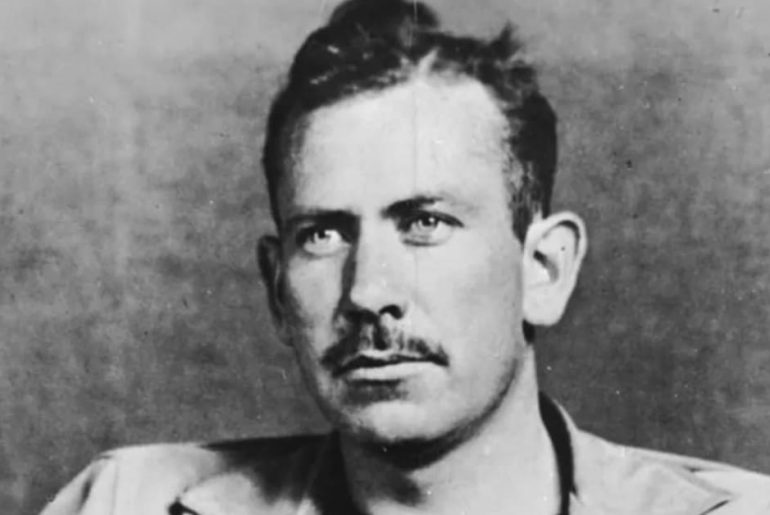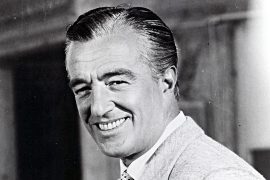John Ernst Steinbeck was born on February 27, 1902 in the coastal town of Salinas, California.
John Steinbeck was a famous 20th-century American writer. Along with William Faulkner, Tennesse Williams and Thornton Wilder, he is one of the most important American writers and one of the most successful and most widely read American authors of the 20th century.
John Steinbeck became known for his socially critical novels, in which he described the misery of poor people and uncovered existing social grievances. The heroes of his socially critical novels are the destitute, outsiders and social fringe groups.
John Steinbeck achieved his breakthrough in 1935 with the novel »Tortilla Flat«, in which he describes the bond of friendship between poor but fun-loving Hispanic-Americans based on the model of King Arthur’s Round Table.
In 1936, after the publication of his novel Stormy Harvest, about a farm workers’ strike, Steinbeck accepted a commission from the San Francisco News to write a series of articles on the uprooted Oklahoma migrant workers.
Crowds of impoverished “Okies” migrated to California in search of jobs. The experiences that Steinbeck gained at that time went into the two works that still impress critics and audiences the most today: the novella »Of Mice and Men« was published in 1937 and the socio-critical novel »Fruits of Wrath« in 1939.
In his socio-critical novel »The Grapes of Wrath«, he describes the fate of uprooted farm workers during the global economic crisis, who left for California with their last belongings to find happiness there.
In his novel “Sardines,” which is set on the street of the same name in his home town of Salinas, a couple of lovable good-for-nothings around their leader Mack always want the best, but always fail gloriously.
Despite all the hostilities, »The Grapes of Wrath« earned Steinbeck the prestigious Pulitzer Prize in 1940. Due to its realistic depiction of the misery of the migrant workers, the book is still regarded not only as a great literary work, but also as a first-class historical source.
In 1944 Steinbeck went to World War II as a war correspondent. He witnessed the Allied landings in North Africa and Italy and published reports about it and his diary entries under the title “At the Gates of Hell”.
Steinbeck now described the everyday life of the soldiers just as sensitively as he had previously described the working-class milieu – not as heroic stories, but as the desperate attempt to survive in dirt, misery and constant danger.
In 1944, Steinbeck returned and moved back to Monterey with his wife and first son.
But he found it increasingly difficult to build on the successes of the pre-war period.
In 1947 Steinbeck traveled with his wife through Scandinavia and France. After another visit to the Soviet Union in 1948 with the photographer Robert Capa, the travelogue »Russian Diary« was created.
After very unstable years and long journeys through North Africa, Southern and Western Europe, John Steinbeck succeeded in 1952 in another great literary coup: the epic novel “East of Eden” – “Beyond Eden” – tells the story of the Trask and Hamilton families from the civil war until the First World War.
In the same year, the screenplay for »Viva Zapata!«, a film about the Mexican revolutionary hero Emiliano Zapata, which Elia Kazan directed with Marlon Brando in the title role, was written. The same director also filmed »Jenseits von Eden« in 1955.
He wrote numerous novels, short stories and short stories, worked part-time as a journalist and was a war correspondent during World War II.
In 1940 he received the Pulitzer Prize and in 1962 the Nobel Prize in Literature.
»The Cannery Row« is one of Steinbeck’s happiest and most optimistic works, with which he dedicated a monument to the city of Monterey, California.
In it, Steinbeck describes the small world around Cannery Row, Monterey’s Cannery Row, and the increasingly lunatic attempts by a group of lovable loafers, bums and bohemians to throw a party for their friend and benefactor Doc.
His best-known novels include Tortilla Flat (1935), The Grapes (1939), Cannery Row (1945), and Beyond Eden (1952).
Steinbeck made a trip to Southeast Asia himself in 1967, but returned a sick man and unable to write.
John Steinbeck died of heart failure on December 20, 1968 in New York. His ashes were buried in his hometown Salinas cemetery.
What did John Steinbeck write?
His best-known works are the novella »Of Mice and Men« and the two novels »The Grapes of Wrath« and »Beyond Eden«. All three works have been filmed several times. John Steinbeck received the Nobel Prize in Literature in 1962.
Which book did John Steinbeck win the Nobel Prize for?
In 1940 he received the Pulitzer Prize for his novel The Grapes of Wrath and in 1962 the Nobel Prize in Literature.
What is the name of the most famous work by the American Nobel Prize winner for literature, John Steinbeck?
American author John Steinbeck (1902-1968) received the Nobel Prize in Literature for 1962. His best known work, ‘Grapes.
When does Grapes of Wrath play?
The Grapes of Wrath, based on the novel by John Steinbeck – 13.10.2022, 20.00 – 22.15 | Theater Cologne.
Where was John Steinbeck born?
Salinas, California, United States
What idea is discussed in both Tim O’Brien’s “Ambush” and John Steinbeck’s “Symptoms”?
The idea discussed in both Tim O’Brien’s “Ambush” and John Steinbeck’s “Symptoms” is the after effects of the combat on the soldiers after a war is over. It talks about what the soldiers go through, their pain and their turmoil once they come back from having faced a war.
Which wars did john steinbeck’s “symptoms” and tim o’brien’s “ambush” discuss?
The war that John Steinbeck discusses in “Symptoms” is World War II. Steinbeck served as a war correspondent during this war, which allowed him to gain first-hand information on the situation of soldiers and veterans. The war that Tim O’Brien writes about, on the other hand, is the Vietnam War.
When did john steinbeck start writing?
Steinbeck’s first novel, Cup of Gold (1929), was followed by The Pastures of Heaven (1932) and To a God Unknown (1933), none of which were successful. He first achieved popularity with Tortilla Flat (1935), an affectionately told story of Mexican Americans.
How might the overall theme of john steinbeck’s books best be described?
John Steinbeck’s books generally had a mournful undertone, as he wrote about social injustices and daily struggles faced by many Americans of his era.
How did john steinbeck die?
John Steinbeck died of heart failure on 20 December 1968, in New York, N.Y, United States. On 4 March 1969, his ashes were buried in the Garden of Memories cemetery in Salinas in the Hamilton Family plot.
What was john steinbeck’s favorite book growing up?
After dropping out of Stanford University, he began writing novels. Around this time, the Great Depression and the Dust Bowl hit, sending thousands of desperate families to California for farm work. Steinbeck was inspired by their stories while interviewing them for a series of articles.
Who were john steinbeck’s parents?
The family farm in Heiligenhaus, Mettmann, Germany, is still named “Großsteinbeck”. His father, John Ernst Steinbeck (1862–1935), served as Monterey County treasurer. John’s mother, Olive Hamilton (1867–1934), a former school teacher, shared Steinbeck’s passion for reading and writing.
What was a result of the efforts of john steinbeck, dorothea lange, and woody guthrie?
They lowered the standard of living for farm workers, and delayed their unionization efforts. The works of John Steinbeck, Dorothea Lange, and Woody Guthrie created an image of the migrant that could not be ignored.
What was john steinbeck’s relationship to the salinas valley?
John Steinbeck’s relationship to the Salinas Valley is that it was his childhood home and he lived there until he went to Stanford University in 1919. Who was John Steinbeck? John Steinbeck was a famous author, and Nobel Peace prize winner. He lived in Salinas, California and went to college at Stanford University.





